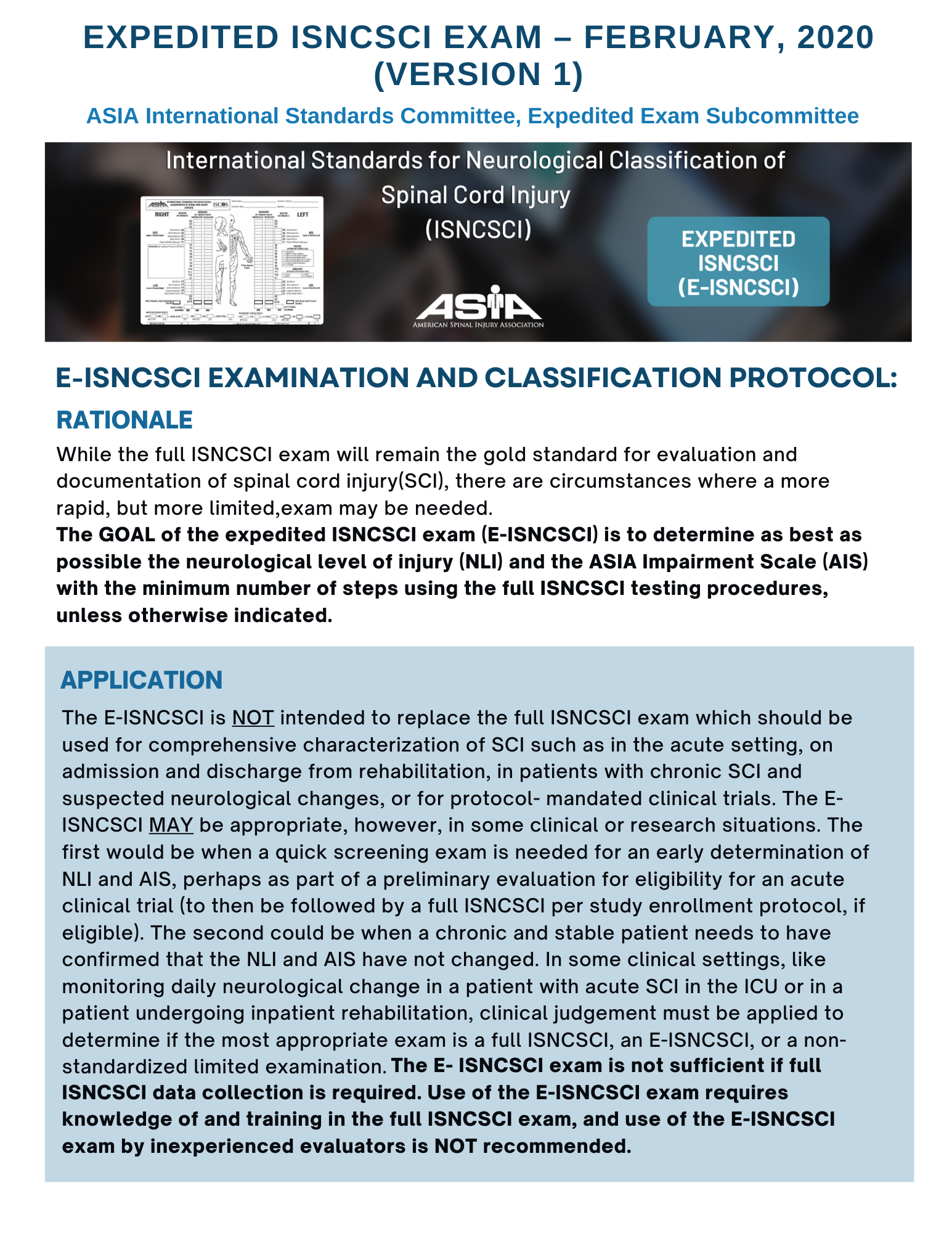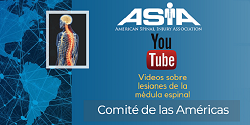.
Expedited ASIA ISNCSCI Exam (E-ISNCSCI)
Version 1 (February 2020)
Developed by the E-ISNCSCI Subcommittee of the ASIA International Standards Committee:
Stephen Burns, MD (subcommittee chair), Keith Tansey, Kristen Walden, Steve Kirshblum, Mary Schmidt, John Steeves, and Dan Graves.
The E-ISNCSCI Exam was developed to provide a more rapid option for determination of the neurological level of injury (NLI) and ASIA Impairment Scale (AIS). Use of the E-ISNCSCI exam may be appropriate in some clinical or research situations, but it is not intended to replace the full ISNCSCI. The protocol uses the same motor and sensory exam techniques as the full ISNCSCI exam, but it allows omission of a large percentage of the individual exam components. Use of the E-ISNCSCI exam requires knowledge of and training in the full ISNCSCI exam. Use of the E-ISNCSCI exam by inexperienced evaluators is not recommended. If there is any doubt as to the accuracy or reliability of the E-ISNSCI exam, or additional information is needed, a full ISNCSCI exam should be performed by a trained evaluator.
.
I. E-ISNCSCI Examination and Classification Protocol

Click here to print the E-ISNCSCI Examination and Classification Protocol
ASIA International Standards Committee, Expedited Exam Subcommittee
.
Rationale
While the full ISNCSCI exam will remain the gold standard for evaluation and documentation of spinal cord injury (SCI), there are circumstances where a more rapid, but more limited, exam may be needed. The GOAL of the expedited ISNCSCI exam (E-ISNCSCI) is to determine as best as possible the neurological level of injury (NLI) and the ASIA Impairment Scale (AIS) with the minimum number of steps using the full ISNCSCI testing procedures, unless otherwise indicated.
Application
The E-ISNCSCI is NOT intended to replace the full ISNCSCI exam which should be used for comprehensive characterization of SCI such as in the acute setting, on admission and discharge from rehabilitation, in patients with chronic SCI and suspected neurological changes, or for protocol- mandated clinical trials. The E-ISNCSCI MAY be appropriate, however, in some clinical or research situations. The first would be when a quick screening exam is needed for an early determination of NLI and AIS, perhaps as part of a preliminary evaluation for eligibility for an acute clinical trial (to then be followed by a full ISNCSCI per study enrollment protocol, if eligible). The second could be when a chronic and stable patient needs to have confirmed that the NLI and AIS have not changed. In some clinical settings, like monitoring daily neurological change in a patient with acute SCI in the ICU or in a patient undergoing inpatient rehabilitation, clinical judgement must be applied to determine if the most appropriate exam is a full ISNCSCI, an E-ISNCSCI, or a non-standardized limited examination. The E- ISNCSCI exam is not sufficient if full ISNCSCI data collection is required. Use of the E-ISNCSCI exam requires knowledge of and training in the full ISNCSCI exam, and use of the E-ISNCSCI exam by inexperienced evaluators is NOT recommended.
Exam Protocol
The sensorimotor exam testing methodology of the E-ISNCSCI is the same as for the full ISNCSCI, unless otherwise noted. The order of exam, however, is designed to most rapidly determine the NLI and the AIS. Unlike the full ISNCSCI exam, the E-ISNCSCI may be performed on patients in the sitting position if necessary, in which case this alternate testing position should be noted. The exam components performed can be recorded on the full ISNCSCI exam scoresheet,1 with notation that the neurologic classification is based on E-ISNCSCI. The E-ISNCSCI exam should proceed as follows:
Determination of the NLI
- On one side of the body, starting at the head, test one sensory modality (e.g. pin prick), in descending fashion through the dermatomes until an abnormal sensation is If the injury level is already known or suspected (i.e. from imaging, prior exam, or other clinical records), it could be possible to start the rostral end of this sensory exam two or three dermatomes rostral to the suspected NLI, adjusting for findings of normal and abnormal dermatomes.
- Once an abnormal level is found, check the same sensation on the contralateral side of the body and the other, as yet untested sensory modality (e.g. light touch), on both sides of the body, sufficiently to identify the most caudal intact dermatomes.
- Once the sensory level is determined, test the key muscles at the level corresponding to the sensory level, and at additional levels rostral and caudal to that level, to the extent that is sufficient to establish the motor level on both sides of the body. Testing of upper limb muscles may likely be omitted when the sensory level is between T4 and L1, but testing should not be skipped if there is patient complaint or clinical evidence of upper extremity motor neuropathology (i.e. weakness, atrophy, spasticity, etc.).
- Follow steps 1-3 from the “Steps in Classification” on the reverse of the full ISNCSCI scoresheet1 to determine the The NLI is the most cephalad of the sensory and motor levels determined.
Determination of the AIS
- Sparing of sensory or motor in the most caudal sacral segment is determined by testing S4-5 sensation bilaterally for light touch and pin prick, plus performing an anorectal examination for deep anal pressure (DAP) sensation and voluntary anal contraction (VAC). As with the full ISNCSCI exam, if S4-5 sensation is absent, DAP is absent, and VAC is absent then the patient has a classification of AIS A (Complete) and no further testing is required. If sensation but not motor (VAC) is present, proceed to step 3) below. If VAC is present, proceed to step 4) below.
- Options to shorten the exam for AIS determination:
a. Optional omission of sacral testing for motor-incomplete injuries:
i. If a prior examination has determined the patient has a motor incomplete injury, and/or motor incompleteness is obvious (presence of voluntary movement more than 3 levels below the motor level on either
side), then the sacral sensorimotor exam (S4-5 sensation and anorectal exam) can be omitted, and testing proceeds to step 4) below
b. Optional sacral testing substitutions:
i. Light touch and pin prick sensation at S1 bilaterally may be substituted for the gold standard ISNCSCI components of S4-5 sensation plus anorectal exam for DAP. However, S1 sensation is predictive of DAP or
S4-5 sensation presence only ~90% of the time2.
ii, Motor function at S1 bilaterally may be substituted for the gold standard ISNCSCI component of VAC. However, S1 motor testing is only ~85% accurate at predicting VAC2. This inaccuracy increases markedly
with NLI’s caudal to T10, and substitution of S1 motor testing for VAC in such cases is strongly discouraged.
iii. If there is absence of S1 sensation for both light touch and pin prick bilaterally and absence of S1 motor bilaterally then the patient can be presumptively classified as AIS A (Complete) and no further testing is required. If any S1 sensation is present but no S1 motor is present, proceed to step 3) If any S1 motor is present, proceed to step 4) below. - If the patient is determined to not be AIS A, motor testing of all key and non-key muscles more than 3 levels below the motor level on each side should be performed. If motor is absent in those muscles and VAC has
not yet been tested then it should be assessed, unless S1 motor bilaterally is being substituted for If there is no motor function detectable in any of these muscles, then the patient can be presumptively classified AIS (Sensory Incomplete) and no further testing is required. If motor is present in at least one of these muscles then the patient has a classification of either AIS C or D (Motor Incomplete) and testing under step 4) below
is performed. - If the patient has a motor incomplete injury, then perform motor testing of all remaining untested key muscles caudal to the NLI to determine if the patient is classified as AIS C AIS D. If less than half of these muscles are 3/5 or greater, the patient is classified as AIS C. If at least half of these muscles are 3/5 or greater, the patient is classified as AIS D. This final step is identical to that used for the full ISNCSCI.
Zone of Partial Preservation: Unless needed for other reasons, a ZPP assessment may be excluded from the E-ISNCSCI exam.
Once the NLI and the AIS have been determined, the patient’s SCI can be considered to have been provisionally characterized. Any recording of the results of this exam should be documented as having come from an E-ISNCSCI exam and not the full ISNCSCI exam, especially if the standard sacral sensorimotor testing (anorectal exam) has not been performed (this should be noted as well). The position of patient testing (sitting or supine) should also be documented. If there is any doubt as to the accuracy or reliability of the E-ISNSCI exam, or additional information is needed, a full ISNCSCI exam should be performed by a trained evaluator.
References
- https://asia-spinalinjury.org/international-standards-neurological-classification-sci-isncsci- worksheet/
- Sacral sparing in SCI: beyond the S4-S5 and anorectal Zariffa J, Kramer JL, Jones LA, Lammertse DP, Curt A; European Multicenter Study about Spinal Cord Injury Study Group, Steeves JD. Spine J. 2012 May;12(5):389-400.
.
II. E-ISNCSCI Cases
The following cases demonstrate the sequence of performing individual exam components for the E-ISNCSCI. For teaching purposes, this testing sequence is superimposed on a completed full ISNCSCI examination with known classification. In general, these cases demonstrate the minimum amount of testing required to confirm the NLI and AIS using the E-ISNCSCI. Frequently, testing of a few additional dermatomes or myotomes is helpful to confirm that neurological levels have been correctly identified.
E-ISNCSCI Case 20-1
E ISNCSCI Case 20-2
E-ISNCSCI Case 20-3
E-ISNCSCI Case 20-4
.
Contact the ASIA office – asia.office@asia-spinalinjury.org if you have any E-ISNCSCI questions.
Requests for Permission to Reprint – E-ISNCSCIIf you would like permission to reprint (examples: book chapters, clinical trials, hospital EMR, etc.) the ASIA ISNCSCI Worksheet, please complete an ASIA Permission to Reprint Form and return, with the exact image/worksheet you would like to use, to the ASIA office for review. If approved, forms will be signed and returned to you within 5 to 10 business days. If permission is not given, you will receive notice with an explanation. ASIA Permission to Reprint Form- E ISNCSCI |







